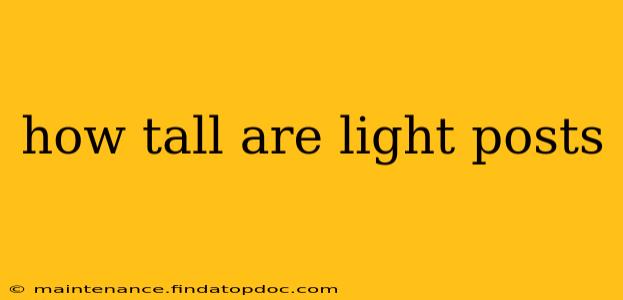The height of a light post, or lamppost, isn't a one-size-fits-all answer. The height varies significantly depending on several factors, making it crucial to understand the context before providing a definitive measurement. This guide explores the typical heights, influencing factors, and answers common questions surrounding light post dimensions.
What are the average heights of light posts?
The average height of a light post ranges widely, typically falling between 10 and 40 feet (3 and 12 meters). However, you'll find exceptions on both ends of this spectrum. Smaller posts might be found in residential areas or parks, while taller ones are often used to illuminate highways, large parking lots, or sports fields. The specific height is determined by a number of factors discussed below.
What factors determine the height of a light post?
Several critical factors influence the height of a light post:
-
Location: The intended environment greatly impacts the necessary height. Residential streets usually require shorter posts, while highways need significantly taller ones to effectively illuminate a wider area. Parking lots and sports fields also have specific lighting requirements leading to varying heights.
-
Purpose: The primary purpose of the lighting plays a crucial role. Street lighting focused on pedestrian safety might have a different height requirement compared to security lighting in a large parking area or stadium lighting aimed at illuminating a vast playing field.
-
Light fixture type: The design and type of lighting fixture, including the bulb type (LED, High-Pressure Sodium, etc.) influence the necessary height for optimal light distribution and coverage. Some fixtures are designed for specific mounting heights to ensure effective illumination.
-
Aesthetics: In certain areas, particularly historic districts or scenic locations, the aesthetic appeal of the light post might dictate its height to maintain architectural harmony and visual consistency.
-
Safety and regulations: Local building codes, safety regulations, and other local ordinances will often specify acceptable height ranges and safety requirements for light posts within a specific jurisdiction.
How high are light posts on residential streets?
Light posts on residential streets are typically shorter, usually ranging from 10 to 15 feet (3 to 4.5 meters). This height provides sufficient illumination for pedestrians and vehicles without being overly obstructive or visually dominant in the neighborhood setting.
How high are light posts on highways?
Highway lighting requires much taller light posts to effectively illuminate the wider roadway and shoulder areas. These posts frequently range from 25 to 40 feet (7.5 to 12 meters) or even taller, depending on the specific highway design and traffic volume.
Are there different types of light posts with varying heights?
Yes, there are many different types of light posts designed for various applications. These differences influence not just the height but also the design, materials, and overall aesthetic. Some examples include:
- Decorative light posts: Often found in parks or historic districts, these posts prioritize aesthetic appeal and can vary significantly in height.
- High-mast lighting: Used for large areas like parking lots or sports stadiums, these systems employ significantly taller poles (often exceeding 40 feet) to provide wide-area illumination.
- Streetlight poles: These come in a wide range of heights depending on the application, as discussed above.
What are the safety considerations for light post heights?
Safety is paramount when determining light post heights. Proper heights ensure adequate illumination without posing hazards like obstructing visibility, creating glare, or presenting a risk of damage or injury. Factors such as visibility during inclement weather and preventing shadows also factor into safe height determinations.
This information provides a better understanding of the various factors that influence light post height. Remember, the height is not arbitrary but rather a carefully considered aspect of effective and safe lighting design.
